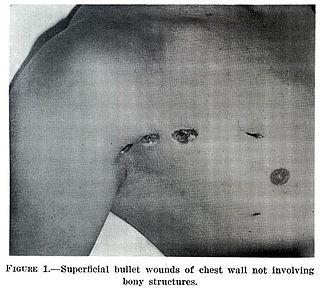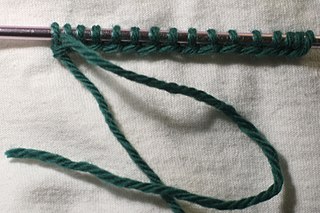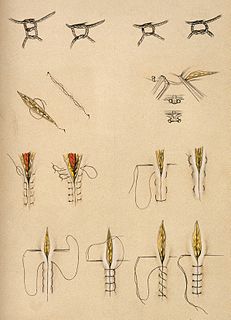
A wound is a type of injury which happens relatively quickly in which skin is torn, cut, or punctured, or where blunt force trauma causes a contusion. In pathology, it specifically refers to a sharp injury which damages the epidermis of the skin.
Stitch, Stitches or Stitched may refer to:
Otoplasty denotes the surgical and non-surgical procedures for correcting the deformities and defects of the pinna, and for reconstructing a defective, or deformed, or absent external ear, consequent to congenital conditions and trauma. The otoplastic surgeon corrects the defect or deformity by creating an external ear that is of natural proportions, contour, and appearance, usually achieved by the reshaping, the moving, and the augmenting of the cartilaginous support framework of the pinna. Moreover, the occurrence of congenital ear deformities occasionally overlaps with other medical conditions.

The surgeon's knot is a surgical knot and is a simple modification to the reef knot. It adds an extra twist when tying the first throw, forming a double overhand knot. The additional turn provides more friction and can reduce loosening while the second half of the knot is tied. This knot is commonly used by surgeons in situations where it is important to maintain tension on a suture, giving it its name.

Hair transplantation is a surgical technique that removes hair follicles from one part of the body, called the 'donor site', to a bald or balding part of the body known as the 'recipient site'. The technique is primarily used to treat male pattern baldness. In this minimally invasive procedure, grafts containing hair follicles that are genetically resistant to balding are transplanted to the bald scalp. Hair transplantation can also be used to restore eyelashes, eyebrows, beard hair, chest hair, pubic hair and to fill in scars caused by accidents or surgery such as face-lifts and previous hair transplants. Hair transplantation differs from skin grafting in that grafts contain almost all of the epidermis and dermis surrounding the hair follicle, and many tiny grafts are transplanted rather than a single strip of skin.

Anal fistula is a chronic abnormal communication between the epithelialised surface of the anal canal and usually the perianal skin. An anal fistula can be described as a narrow tunnel with its internal opening in the anal canal and its external opening in the skin near the anus. Anal fistulae commonly occur in people with a history of anal abscesses. They can form when anal abscesses do not heal properly.
A seroma is a pocket of clear serous fluid that sometimes develops in the body after surgery. This fluid is composed of blood plasma that has seeped out of ruptured small blood vessels and the inflammatory fluid produced by injured and dying cells.. Seromas are different from hematomas, which contain red blood cells, and abscesses, which contain pus and result from an infection. Serous fluid is also different from lymph.
Mastopexy is the plastic surgery mammoplasty procedure for raising sagging breasts upon the chest of the woman, by changing and modifying the size, contour, and elevation of the breasts. In a breast-lift surgery to re-establish an aesthetically proportionate bust for the woman, the critical corrective consideration is the tissue viability of the nipple-areola complex (NAC), to ensure the functional sensitivity of the breasts for lactation and breast-feeding.

Veterinary surgery is surgery performed on animals by veterinarians, whereby the procedures fall into three broad categories: orthopaedics, soft tissue surgery, and neurosurgery. Advanced surgical procedures such as joint replacement, fracture repair, stabilization of cranial cruciate ligament deficiency, oncologic (cancer) surgery, herniated disc treatment, complicated gastrointestinal or urogenital procedures, kidney transplant, skin grafts, complicated wound management, and minimally invasive procedures are performed by veterinary surgeons. Most general practice veterinarians perform routine surgeries such as neuters and minor mass excisions; some also perform additional procedures.

In knitting, casting on is a family of techniques for adding new stitches that do not depend on earlier stitches, i.e., having an independent lower edge. In principle, it is the opposite of binding off, but the techniques involved are generally unrelated.
A barbed suture is a type of knotless surgical suture that has barbs on its surface. While suturing tissue, these barbs penetrate inside the tissue and lock them into place, eliminating the need for knots to tie the suture. Conventional sutures rely on a surgeon's ability to tie secure knots; barbed sutures provide a knotless alternative in some surgical situations. Barbed sutures are primarily used in cosmetic surgery.

The vertical mattress stitch, often called vertical Donati stitch, is a suture type used to close skin wounds. The advantages of the vertical mattress suture are that it provides closure for both deep and superficial layers, and also allows perfect eversion and vertical opposition of the superficial skin edges. Its disadvantage is a relatively high propensity to dig into skin and cause prominent stitch mark scars.

The horizontal mattress stitch is a suture technique used to close wounds. It everts skin well and spreads tension along the wound edge. This makes it ideal for holding together fragile skin as well as skin under high tension such as the distant edges of a large laceration or as the initial holding suture in complicated repairs.

Surgical suture is a medical device used to hold body tissues together after an injury or surgery. Application generally involves using a needle with an attached length of thread. A number of different shapes, sizes, and thread materials have been developed over its millennia of history. Surgeons, physicians, dentists, podiatrists, eye doctors, registered nurses and other trained nursing personnel, medics, clinical pharmacists and veterinarians typically engage in suturing. Surgical knots are used to secure the sutures.

Wound closure strips are porous surgical tape strips which can be used to close small wounds. They are applied across the laceration in a manner which pulls the skin on either side of the wound together. Wound closure strips may be used instead of sutures (stitches) in some injuries, because they lessen scarring and are easier to care for.

Circumcision surgical procedure in males involves either a conventional "cut and stitch" surgical procedure or use of a circumcision instrument or device. In the newborn period, almost all circumcisions are done by generalist physicians using one of three surgical instruments. In the US, the Gomco clamp is the most utilized instrument, followed by the Mogen clamp and the Plastibell. They are also used worldwide.

Surgical knots (ligatures) are the knots used to bind suture materials together while binding tissue in surgery. They are used in medical and veterinary settings.
The Merck stitch method is a minimally invasive procedure for pinning protruding ears, developed by Merck. The method belongs to the special types of ear pinning surgeries. In contrast to other variations of minimally invasive procedures the stitch method does not use additional techniques from the traditional ear pinning surgeries (otoplasty). It belongs to the closed ear pinning surgeries because the ear is not cut open for the placement of the sutures. According to the experience of the author the Stitch Method is suitable for all protruding ears. The stitch method is the most frequently performed otoplasty among the minimally invasive methods.
Thyroplasty is a phonosurgical technique designed to improve the voice by altering the thyroid cartilage of the larynx, which houses the vocal cords in order to change the position or the length of the vocal cords.

A ladder stitch, or mattress stitch, is a stitch which can be used to invisibly close seams from the outside of the garment or item. It is primarily used to close seams on stuffed items, such as pillows, mattresses, down coats or stuffed toys, where after the stuffing is added, there is no access to the back of the fabric. It can also be used to repair split seams on theses items or garments, or to alter clothing.














